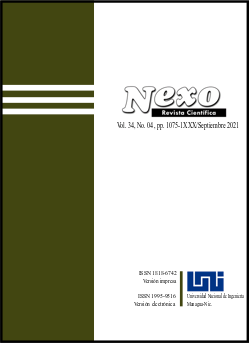Developing and exploring the characteristics of optical-fibre vibration sensor
DOI:
https://doi.org/10.5377/nexo.v34i04.12692Keywords:
Optical fibre, Optical-fibre sensor, Sensor of physical values, Semiconductor lase, Vibration sensorAbstract
Integration of optics into microelectronics is extremely attractive in terms of further microminiaturisation and information transmission rate. Hence, the article aims at opening up and studying all the opportunities that can be taken from a simple optical sensor that is based on reflection of light from an oscillating surface.To measure vibrations, a principle of determining the amplitude of a diverging cone of light has been employed depending on the distance to an oscillating surface. The most common optical fibre with the numerical aperture of 0.12 was used in the experiments. The wavelength of laser utilised in the sensor is 1310nm. A laser with 640nm wavelength was used in the control stand measurement path. The conducted studies resulted in creating a simple vibration sensor on the basis of optical fibre with the use of laser, photo-diode, and splitter. It has been experimentally shown that the amplitude of the reflected light changes exponentially depending on the distance to the oscillating surface. The accuracy of interferometric measurements was 22nm. The coherence length of lasers used in the interferometer amounted to 2mm, what well sufficed to obtain a contrast interference pattern. Vibrations of various surfaces from 500µm to 22nm were measured. A major plus of the sensor is its maximum ease and a rather high accuracy of measurements. Measured frequency of vibrations is limited only to the transfer characteristic of an electronic part of the sensor. The article materials are of practical value for using their principles in micro-accelerometers, angular velocity sensors, and many other sensors of physical values.
Downloads
1523
Downloads
Published
How to Cite
Issue
Section
License
Copyright (c) 2021 Universidad Nacional de Ingeniería

This work is licensed under a Creative Commons Attribution-NonCommercial-NoDerivatives 4.0 International License.
The authors who publish in Nexo Scientific Journal agree to the following terms:
- Authors retain the copyright and grant the journal the right of the first publication under the license Creative Commons Attribution License, which allows others to share the work with a recognition of the authorship of the work and the initial publication in Nexo Scientific Journal.
- Authors may separately establish additional agreements for the non-exclusive distribution of the version of the work published in the journal (for example, in an institutional repository or a book), with the recognition of the initial publication in Nexo Scientific Journal.
- Authors are allowed and encouraged to disseminate their works electronically (for example, in institutional repositories or in their own website) before and during the submission process, as it can lead to productive exchanges, as well as earlier and greater citation of published works.










